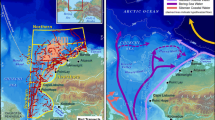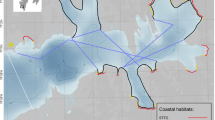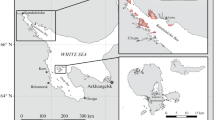Summary
The early spring distribution of seabirds, pinnipeds and cetaceans was quantitatively determined in the northern Weddell Sea during the EPOS 1 cruise of the icebreaking RV Polarstern. Two hundred and ninety-one half hour counts were made in the Antarctic region between October 18 and November 16, 1988 (+94 counts in sub-antarctic and sub-tropical water). The bird populations were dominated by the Adélie Penguin Pygoscelis adeliae, which represented 90% of the birds counted in the closed pack ice (CPI), with a mean density of 31 penguins per km2. Crabeater seal Lobodon carcinophagus, the most common pinniped, had a mean density of 1.2/km2 in the CPI with local concentrations reaching 14/km2. Expressed as biomass, mean values of about 90 kg/km2 were found in the whole Antarctic zone for seabirds, 50 for seals, and 35 for baleen cetaceans. Densities were higher in the CPI: 140, 180 and 115 kg/km2 respectively, were found for birds, pinnipeds and baleen whales, and lowest in open water (8 kg/km2 for the birds, 0.2 for the pinnipeds and no whales). A minimum value of food intake by seabirds and marine mammals was estimated to be 2.7 mg C/m2/day for the Antarctic zone (4.1 in the CPI). Taking into account that pinnipeds density and cetacean food uptake are underestimated, and that Antarctic seabirds consume much more fish than generally suspected, a minimum krill production of 16 mg C/m2/day is proposed for the Antarctic zone: 22.5 in the CPI, 3 in open water, and intermediate values in the marginal ice zones.
Similar content being viewed by others
References
Abrams RW (1985) Energy and food requirements of pelagic aerial seabirds in different regions of the African sector of the Southern Ocean. In: Siegfried WR, PR Condy and RM Laws (eds) Antarctic nutrient cycles and food webs. Springer, Berlin Heidelberg New York, pp 466–472
Ainley DG, Fraser WR, Hopkins TL, Torres JJ, Smith WO Jr, Sullivan CW (1991) The structure of upper level pelagic food webs in the Antarctic: effect of prey distribution. J Mar Syst (in press)
Ainley DG, O'Connor EF, Boekelheide RJ (1984) The marine ecology of birds in the Ross Sea, Antarctica. Ornithol Monogr 32 (AOU, Washington DC)
Bonner WN (1981) Southern fur seals. In: Ridgway SH and Harrison RJ (eds) Handbook of marine mammals vol 1. Academic Press, New York pp 161–208
Bonner WN, Laws RM (1964) Seals and sealing. In: Priestly R, Adie RJ, Robin G de Q (eds) Antarctic research. Butterworths, London, pp 163–190
Bourne WRP (1982) The manner in which wind drift leads to seabird movements along the east coast of Scotland. Ibis 124:81–88
Bourne WRP, Warham J (1966) Geographical variation in the Giant Petrels of the genus Macronectes. Ardea 54:45–67
Brown RNR (1913) (1915?) The seals of the Weddell Sea. Notes on their habits and distribution. Rep Nat Antarct Exped 1902–4 4:185–198 (cited in Smith and Burton)
Cline DR, Siniff DB, Erickson AW (1969) Summer birds of the pack ice in the Weddell Sea, Antarctica. Auk 86:701–716
Conroy JWH, Darling OHS, Smith HG (1975) The annual cycle of the Chinstrap penguin Pygoscelis antarctica on Signy Island, South Orkney Islands. In: Stonehouse B (ed) The Biology of penguins. MacMillan, London, pp 353–362
Crossin RS (1974) The storm petrels (Hydrobatidae). In: King WB (ed) Pelagic studies of seabirds in the central and eastern North Pacific Ocean. Smithson Contrib Zool 158:154–205
Croxall JP (ed) (1987) Seabirds: feeding ecology and role in marine ecosystems. Cambridge University Press, 408 pp
Croxall JP, Lishman GS (1987) The food and feeding ecology of penguins. In: Croxall JP (ed) Seabirds: feeding ecology and role in marine ecosystems. Cambridge University Press, pp 101–133
Devillers P, Terschuren JA (1980) Les pétrels géants (Macronectes sp) des îles Falkland et du sud de l'Amérique du Sud. Gerfaut 70:447–454
Diamond AW, Gaston AJ, Brown RGB (1986) Converting PIROP counts of seabirds at sea to absolute densities. Can Wild Serv, Progr Notes 164:21
Eicken H, Lange M (1989) Sea ice conditions. Rep Pol Res 62:55–63
Erickson AW, Hanson MB (1990) Continental estimates and population trends of Antarctic ice seals. In: Kerry KR, Hempel G (eds) Antarctic ecosystems. Ecological change and conservation. Springer; Berlin, Heidelberg, New York, pp 253–264
Erickson AW, Siniff DB, Cline DR, Hofamn RJ (1971) Distributional ecology of Antarctic seals. In: Deacon G (ed) Symposium of Antarctic ice and water masses. Proc Sci Comm Antartct Res, Brussels, pp 55–76
Fraser WR, Ainley DG (1986) Ice edges and seabird occurrence in Antarctica. BioScience 36:258–263
Griffith AM, Siegfried WR, Abrams RW (1982) Ecological structure of a pelagic seabird community in the southern Ocean. Polar Biol 1:39–46
Heinemann D, Hunt G, Everson I (1989) Relationships between the distributions of marine avian predators and their prey, Euphausia superba, in Bransfield Strait and southern Drake Passage, Antarctica. Mar Ecol Prog Ser 58:3–16
Joiris C (1978) Seabirds recorded in the northern North Sea in July: the ecological implications of their distribution. Gerfaut 68:419–440
Joiris C, Billen G, Lancelot C, Daro MH, Mommaerts JP, Bertels A, Bossicart M, Nijs J, Hecq JH (1982) A budget of carbon cycling in the Belgian coastal zone: relative roles of zooplankton, bacterioplankton and benthos in the utilization of primary production. Neth J Sea Res 16:260–275
Joiris CR (1989) Seabirds in the North Sea: distribution and ecological role. ICES, CM. 1989/N:8
Joiris CR (1991) Distribution and ecological role of seabirds and marine mammals in the Norwegian and Greenland seas (June 1988). Pol Res (in press)
Joiris CR, Tahon J (1991) Distribution and ecological role of seabirds and marine mammals in the Norwegian and Greenland seas (July 1988). J Mar Syst (in press)
Kooyman GL, Davis RW, Croxall JP, Costa DP (1982) Diving depths and energy requirements of King Penguins. Science 217:726–7
Larsson AM, Sehlstedt PI, Bianchi F, Socal G, Cioce F, Nöthig EM, Dieckmann G, Bouquegneau JM (1990) Hydrographical, chemical and biological observations during the European Polarsterm Study — EPOS, leg 1. Dept of Oceanography, University of Gothenburg, Sweden
Lasiewski RC, Dawson WR (1967) A re-examination of the relation between standard metabolic rate and body weight in birds. Condor 69:13–23
Lishman GS (1985) The food and feeding ecology of Adélie and Chinstrap Penguins at Signy Island, South Orkney Islands. J Zool London 205:245–263
Lockyer C (1981) Growth and energy budgets of large baleen whales from the southern hemisphere. In: Mammals in the seas, vol 3. FAO Fish Ser 5, vol. 3. Rome, pp 379–487
Mansfield AW (1958) The breeding behaviour and reproductive cycle of the Weddell seal (Leptonychotes weddelli Lesson). Falkland Islands Depend Surv Sci Rep 18, 41 pp (cited in Smith and Burton)
Ohsumi S, Kasamatsu F (1982) Whale sighting efficiency of the crew on board Sympsium on Antarctic Biology. Mem Nat Inst Polar Res, spec issue 23:108–122
Øritsland T (1970) Biology and population dynamics of Antarctic seals. In: Holdgate MW (ed) Antarctic ecology. Academic Press, New York, pp. 361–366
Ray C (1970) Population ecology of Antarctic seals. In: Holdgate MW (ed) Antarctic ecology. Academic Press, New York, pp 398–414
Schneider DC, Hunt GL, Powers KD (1987) Energy flux to pelagic birds: ecology and role in marine ecosystems. Cambridge University Press, Cambridge, pp 259–277
Siegel V, Bergström B, Strömberg JO, Schalk PH (1990) Distribution, rise frequencies and maturity stages of krill, Euphausia superba, in relation to sea-ice in the northern Weddell Sea. Polar Biol 10:549–557
Siniff DB, Cline DR, Erickson AW (1970) Population densities of seals in the Weddell Sea, Antarctica, in 1968. In: Holdgate MW (ed) Antarctic ecology. Academic Press, New York, pp 377–394
Smith EA, Burton RW (1970) Weddell seals of Signy Island. In: Holdgate MW (ed) Antarctic ecology. Academic Press, New York, pp 415–428
Solyanik GA (1964) Some information about the seals of the Antarctic. Inf Byull Sov Antarkt Eksped 47:54–59 (cited in Siniff et al.)
Wiens JA, Heinemann D, Hoffman W (1978) Community structure, distribution and inter-relationships of marine birds in the Gulf of Alaska. Final Rep Principal Invest, vol 3. Boulder, Colorado, NOAA
White MG, Conroy JWH (1975) Aspects of competition between pygoscelid penguins at Signy Island, South Orkney Island. Ibis 117:371–373
Zink RM (1981) Notes on birds of the Weddell Sea, Antarctica. Gerfaut 71:59–74
Author information
Authors and Affiliations
Additional information
Data presented here were collected during the European Polarstern Study (EPOS) sponsored by the European Science Foundation
Rights and permissions
About this article
Cite this article
Joiris, C.R. Spring distribution and ecological role of seabirds and marine mammals in the Weddell Sea, Antarctica. Polar Biol 11, 415–424 (1991). https://doi.org/10.1007/BF00233076
Received:
Accepted:
Issue Date:
DOI: https://doi.org/10.1007/BF00233076




